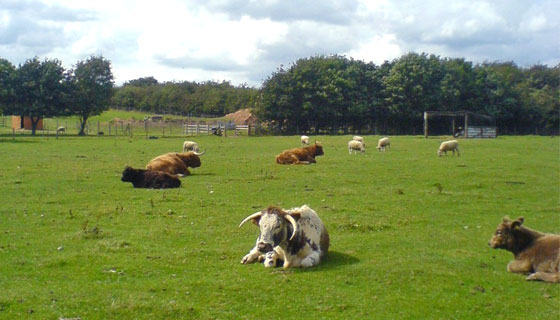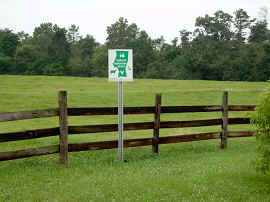Authorized by the North Carolina General Assembly in the 1985 Farmland Preservation Enabling Act (61:106-738) and implemented at the county level, Voluntary Agricultural Districts (VADs) and Enhanced Voluntary Agricultural Districts (EVADs) help form partnerships between farmers, county commissioners and land use planners to pass ordinances that encourage the voluntary preservation of farmland, support the productive use of agricultural land, and protect land from urban development.
VADs and EVADs are part of the North Carolina Agricultural Districts program, which recognizes the importance of agriculture in North Carolina and fosters growth, development and sustainability of family farms. As of June 2004, 39 of North Carolina’s 100 counties had passed farmland preservation ordinances establishing VAD programs.
Why is this important to your community?
The CONNECT Region is home to nearly 14,500 farmers and 10,000 farms, 77% of which are small to mid-sized farms. However, low sales figures, increased suburbanization, population growth in rural areas, and local land use regulations often make it difficult to operate small and mid-sized farms.
The region’s farm economy is in a period of transition. Only 5% of the regions farms are growing fresh fruits and vegetables; however, the number of farms involved in direct sales to consumers is rising and there is a proven demand for local food products. One of the CONNECT priorities, Support Local Farms, aims to protect the rural beauty of the region’s farms, while creating jobs and supporting economic development. However, in some counties, new regulations permit the classification of large-lot residential and other non-productive land as agricultural farmland, making it more difficult for farming to remain economically viable.
VADs and EVADs give farmers multiple protections. For example, VAD and EVAD ordinances can protect enrolled farmers not connected to water or sewer systems operated by a county from water & sewer assessments. Any cost share charged to a landowner for implementation of these practices has to be held in abeyance for farmers enrolled in the program. In addition to providing direct benefits to landowners, VADs and EVADs brings the general public benefits such as protecting a community’s rural heritage and economy, providing and maintaining local jobs and tax income; preserving scenic views and tourism-based economic activity; contributing to clean air and water; and minimizing the infrastructure burden on county and local governments.
Skip directly to
How Does It Work?
Resources
Using the Tool
Partners
Where Has It Worked?
Where is it appropriate to use?
What priorities does it address?
What other tools are related?
How does it work?
Voluntary Agricultural Districts (VADs) and Enhanced Voluntary Agricultural Districts (EVADs) are used to encourage the voluntary preservation of farmland, support its productive use for agriculture, and limit urban development of farmland. VADs require the creation of an Agricultural Advisory Board to administer the program, reviews and approves applications for qualifying farmland, and establishes the agricultural district and Agriculture Protection Plan.
VADs and EVADs provide protection against farm nuisance lawsuits1 and priority consideration for NCDA grants. VADs are well-established in North Carolina; however, South Carolina is one of the few states that lack any voluntary agricultural district programs at this time. All of the North Carolina counties surrounding Mecklenburg have an established Voluntary Agriculture District ordinance.
1 Farm nuisance lawsuits involve a neighbor suing a farmer to force the farmer to stop a particular farming activity or to pay damages for farming actions that the neighbor considers harmful. Such lawsuits typically start when the neighbor claims that farming activities nearby prevent him or her from enjoying their property
Resources
- One North Carolina Naturally
- Appalachian Sustainable Agriculture Projects (ASAP)
- Carolina Farm Stewardship Association (CFSA)
- CONNECT Our Future Food Systems Assessment Report (LINK)
- CONNECT Our Future Action Plan for Food Systems Improvement (LINK)
- Enhanced Farmland Protection for North Carolina Landowners (NCADFP)
- North Carolina Voluntary Agricultural Districts (NCADFP)
- North Carolina Voluntary Agricultural Districts: A Progress Report
Ready to get started?
Using the Tool
- Identify key landowners, farmland conservation organizations and other respected advocates in the municipality, county, or region.
- If located in North Carolina, determine if a Voluntary Agriculture District ordinance already exists in your county or municipality by consulting http://wfs.enr.state.nc.us/pages/WL_VAD.html.
- If a VAD ordinance exists, assess existing areas of your county/municipality that are currently participating.
- Survey participants to understand the challenges and successes of the current ordinance, including opportunities to strengthen the current ordinance.
- If applicable, use resources available at the state level to develop a proposal for county commissioners requesting approval to develop an Enhanced Voluntary Agricultural District (EVAD) ―e.g., North Carolina Department of Environmental and Natural Resources, One North Carolina Naturally initiative. EVADs receive all VAD benefits, plus they may receive up to 25% of its gross sales from the sale of nonfarm products and still qualify as a bona fide farm that is exempt from zoning regulations under G.S. 153A-340(b). EVADs are also eligible to receive a higher percentage of cost share funds under the Agriculture Cost Share Program pursuant to Part 9 of Article 21 of Chapter 143 of the General Statutes.
- Develop a committee or working group that includes farmers and advocates to develop the VAD or Enhanced VAD ordinance. The Land Preservation Notebook of North Carolina State University (NCSU) offers model Farmland Protection Plan Review and present the ordinance language to the county/municipal commissioners for adoption/approval. VAD ordinances must be passed by a majority vote of the county commission.
- If located in South Carolina:
- Meet with local landowners, farmland conservation organizations and local planning staff to gauge interest and support in establishing a VAD ordinance to preserve local farms. Work with your local food council and other respected advocates.
- Consider developing a county voluntary agricultural district or farmland protection ordinance for review and adoption by the county commissioners.
- Present your proposal to the county commissioners to request their approval to proceed.
- Convene a committee to write the ordinance. Consult NCSU’s Land Preservation Notebook for model Farmland Protection Plan
- Take the ordinance back to the county commission for adoption.
Partners
Where has it worked?
Catawba County - Catawba County, NC
 Image Source: Catawba County Government, North Carolina.
Image Source: Catawba County Government, North Carolina.
Contact
Jacky Eubanks, Planning & Parks Director
JEubanks@catawbacountync.gov
About the Program
Catawba County, in an effort to preserve and protect farmland from non-farm development, adopted a Voluntary Agricultural District ordinance in 2008. Landowners who join the VAD agree to not develop their land for at least ten years in exchange for farm member signage, protection from farm nuisance suits, funding eligibility, and an official role in government. Farm owners can also opt into the Enhanced Voluntary Agriculture District program where they are required to enter into a binding agreement to not develop their land for 10 years in exchange for a higher percentage of cost share funds, priority consideration for farmer assistance grants, and are permitted to collect up to 35% of sales from non-farm products.
Why it works
Catawba County’s VAD program has successfully protected and preserved more than 9,200 acres of farmland, almost 13% of total farmland in the county, including 515 acres in 2013 alone. By protecting farmland and assisting farmers, the VAD program helps increase community pride and raise awareness of the important role the agricultural community plays in the county. Following the adoption and positive reception of the VAD program, the Agricultural Advisory Board (a board formed to administer the program), worked with VAD farmers and partners in the county to develop a Farm & Food Sustainability Plan focusing on the issues related to the long-term sustainability of farms.
http://www.catawbacountync.gov/Planning/General/VolAgDistrict.asp
http://www.catawbacountync.gov/Planning/General/VADAnnualReport.pdf
Countywide Farmland Protection Plan - Iredell County, NC
 Image Source: Iredell County Government.
Image Source: Iredell County Government.
Contact
Matthew Todd, Planning Division Manager
Iredell County Development Services
704-878-3127
mtodd@co.iredell.nc.us
About the Program
Iredell County adopted a Voluntary Agricultural District ordinance in June 2001. Also pursuant to the ordinance, a Farmland Preservation Advisory Board was appointed by the Board of County Commissioners to represent agricultural interests in the county.
In 2008, the Iredell County Commission adopted a comprehensive, countywide Farmland Protection Plan, prepared by the Farmland Preservation Advisory Board. The Plan serves as an umbrella to coordinate a variety of ordinances (including the 2001 VAD, actions and programs designed to “maintain a viable agricultural community and address farmland preservation tools, such as agricultural economic development, including farm diversification and marketing assistance; other kinds of agricultural technical assistance, such as farm infrastructure financing, farmland purchasing, linking with younger farmers, and estate planning; the desirability and feasibility of donating agricultural conservation easements, and entering into voluntary agricultural districts.” The County’s Farmland Preservation Advisory Board is charged with administering the plan and reporting to the Board of County Commissioners on its progress.
Why it works
Agriculture faced many challenges at the time of the adoption of the VAD, including falling commodity prices, escalating input costs and low profitability; rising property values and taxes; conflicts with non-farming neighbors; and loss of supporting local farm services. In addition, many farm operators were aging, threatening the loss of generations of farming expertise and failure of many farms without younger farmers to take over production. The 1997 Iredell County Land Use Plan did not even make reference to agricultural lands in Iredell County (this changed when the county updated its Land Use Plan, after 2008).
Although the VAD ordinance encourages investment in agriculture, it does not represent a permanent land protection measure as districts rely heavily on voluntary enrollment and allow for withdrawal. However, the VAD is one of several complementary protections adopted by Iredell County as part of its comprehensive Farmland Protection Plan:
- In 2005 Iredell County adopted a Purchase of Development Rights (PDR) program (modeled for the Agricultural Conservation Easements Program, or PACE) to preserve large tracts of land for the protection of agriculture and open space.
- In 2007, the County adopted an EVAD Program. This program is based on a 10 year irrevocable agreement with the county to forego developing their land for a period of ten years
Today, Iredell County’s family farms produce a diverse array of agricultural products, including but not limited to dairy, beef cattle, hatching eggs, corn silage, small grain, nursery crops, etc. Agriculture is ranked as Iredell County’s number one industry, accounting for $165,928,000 Total Market Value of Production (according to the 2012 USDA Census of Agriculture). This illustrates agriculture’s importance to the local economy.
http://www.co.iredell.nc.us/Departments/Planning/farmland.aspx
http://www.co.iredell.nc.us/Departments/Planning/forms/protectionplan_final071808.pdf


